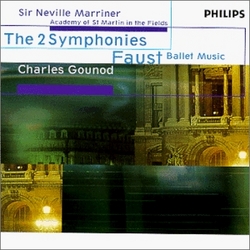| All Artists: Charles Gounod, Neville Marriner, Academy of St. Martin-in-the-Fields Title: Gounod: The 2 Symphonies; Faust Ballet Music Members Wishing: 1 Total Copies: 0 Label: Philips Release Date: 7/20/1999 Genre: Classical Styles: Opera & Classical Vocal, Symphonies Number of Discs: 1 SwapaCD Credits: 1 UPC: 028946212523 |
Search - Charles Gounod, Neville Marriner, Academy of St. Martin-in-the-Fields :: Gounod: The 2 Symphonies; Faust Ballet Music
 | Charles Gounod, Neville Marriner, Academy of St. Martin-in-the-Fields Gounod: The 2 Symphonies; Faust Ballet Music Genre: Classical
|
Larger Image |
CD DetailsSimilar CDs
Similarly Requested CDs
|
CD ReviewsIt Dances! 01/30/2004 (5 out of 5 stars) "Like the reviewer who preferred John Lubbock's performance of these symphonies on ASV, I gave high marks to Lubbock's disc elsewhere on the Amazon Web site. But listening again to this Philips CD (to tell the truth, I have so many CDs that I forgot it was in my collection!), I found Marriner not at all opaque or lumbering. Instead, I think he captures just as well as Lubbock the gentility and sprightliness of these very fine little symphonies that inspired Bizet's glowing Symphony in C. Yes, that scherzo from the Second Symphony is a pencil sketch for the more famous "Funeral March of a Marionette," but jazzed up and with a more Puckish drollery. Wonderful. And the last movement, maybe the finest in both symphonies is this Frenchman's own "apotheosis of the dance." Marriner and his well-oiled machine of an orchestra capture it all with grace and elegance. Great music this is not, but I hope there is a place for such first-rate second-rank music!With the Faust Ballet Music we have the product of a perhaps more skilled and experienced musician, but he's pandering here to the French taste for spectacle, and even though the music has its moments, it's somewhat trashy compared with the urbane utterance of the symphonies, for my money. Still, it's good, clean fun and underlines the essentially balletic nature of Gounod's orchestral music-making--true right up to the marvelous Petite Symphonie of the composer's last years.In the Ballet Music, that protean ASMF Orchestra sounds properly beefier and heftier, producing gorgeous sounds that most pit orchestras (the Met Orchestra excluded) could never produce. Add to this a very refined recording from Philips--finer, I think, than the one on ASV--and you have a better bargain with this excellent Marriner disc." Gounod's neglected symphonies Robert E. Nylund | Ft. Wayne, Indiana United States | 01/28/2004 (4 out of 5 stars) "Possibly inspired by fellow Frenchman Georges Bizet, Charles Gounod composed two symphonies in 1855, the same year Bizet wrote his only true symphony. (Bizet also composed an extended symphonic work, "Roma," that is sometimes called a symphony.) Bizet's symphony was not performed in his lifetime; in fact, the first performance of it didn't occur until 1935, 80 years after it was written.Gounod's symphonies suffered similar neglect. In fact, Gounod's two symphonies are seldom performed or recorded even now, while Bizet's symphony has enjoyed numerous performances and recordings. It's really hard to understand why Gounod's symphonies continue to be neglected. As these fine recordings demonstrate, the music is very charming and filled with emotion, while obviously influenced by Haydn and Beethoven. It is known that Paris tended to be musically conservative and certainly Gounod recognized that; nevertheless, he failed to attract much attention with these works.I find the first symphony, written in D major, the more enjoyable of the two. It often reminds me of Bizet's symphony in C major, but it definitely has originality and deserves to be heard more often.Sir Neville Marriner and the Academy of St. Martin in the Fields give very competent, enjoyable performances of the symphonies. They really excel in the showy ballet music Gounod composed for his 1859 masterpiece, the opera "Faust." French opera HAD to include ballet in those days because the patrons, especially the wealthy, aristocratic members of the Jockey Club, expected it. There was, of course, some scandal connected with "Faust" because of its religious themes. Gounod followed Goethe's interpretation of the Faust legend of Faust repenting, being forgiven, and being taken to heaven by angels.The ballet music, however, definitely is more in keeping with the presence of the devil, who continues to tempt and "encourage" Faust in his worldly pursuits. It has always been one of the very lively operatic ballets and the performance here maintains the excitement." Unknown symphonies deserve more performances HB | Fort Mill, SC | 06/23/2005 (5 out of 5 stars) "If you live in USA, the chance of hearing either of the Gounod symphonies is very poor. American orchestras rarely play short, easygoing symphonies like these two works. Even the early Schubert symphonies are rarely played. These two works of Gounod are not great masterpieces but they are delightful and these performances are magnificent. As a bonus there is the wonderful ballet music from "Faust", a real masterpiece."
|

 Track Listings (15) - Disc #1
Track Listings (15) - Disc #1











